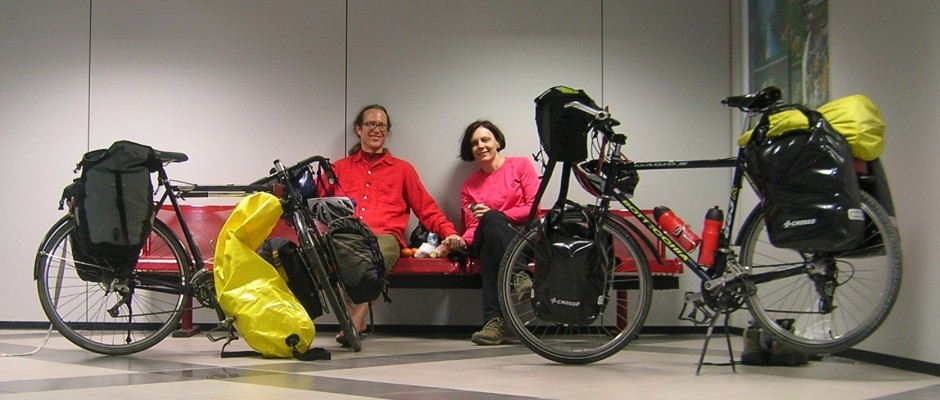A little weather research indicates that March may be early for cycling in the Pyrenees. It’s still ski season, and of course the famous Col du Tourmalet is almost guaranteed to be closed. Kurt and I were hoping to at least get into the foothills of the Pyrenees on the warmer Spanish side and see what happens from there. We had rainy and cold weather when we started the trip in Madrid. However, the weather forecast after that continually showed sunny and surprisingly warm weather for March.
There are lots of routes a bicyclist can choose through the high Pyrenees, but there are a few passes with tunnels where it’s prohibited to ride. Not all tunnels, however, are forbidden for cyclists, and amazingly the French IGN “cartes de promenade pour découvrir la France à vélo ou à pied” maps do not indicate which tunnels are prohibited for cyclists. With a little prior internet research, it’s probably pretty easy to figure out what’s going on. We, however, relied on the tourist information offices which only can answer questions within a surprisingly small nearby area. For example, in Laruns we learned that Col d’Ausbique was still closed because of snow, but they didn’t know the status of any passes beyond their own valley (Col d’Aspin, e.g.).
We got in trouble at one tunnel. We had come down from Alto de Fanlo into the beautiful Cañon de Añisclo, turned north at Escalona, and started the climb to the Bielsa-Aragnouet Tunnel. It wasn’t until 25km later in Bielsa that we saw the first sign indicating cyclists were prohibited in the tunnel. Pretty lame — an earlier warning would be appreciated. We only had about 8km left to climb at that point. We continued anyway and ended up hitchhiking for two hours to a get a 5km ride through the tunnel. There was no poaching that tunnel as a worker had very clearly and seriously told us that cyclists were definitely not allowed in the tunnel. He wasn’t helpful in getting us through. A young French couple kindly gave us the short ride into France.
We ended up cycling four passes on the France-Spain border, the famous Col de Peyresourde in France, and four other passes on the Spanish side, including the highest one of the trip, Port de la Bonaigua. Ironically the lowest of these high passes, Col de Portillon above Bagnères de Luchon, was the hardest of them all (except for the one dirt road pass, Alt de Sant Joan de l’Erm Vell).
On our two forays into France we spent only a total of three days, but as I’m reminded every time I go to France, it’s a great country (I’ve now cycled in France on the border with Italy, Switzerland, Germany, and Spain). One thing that keeps surprising Turks when I tell them about this trip is how friendly the French were but the Spanish weren’t. Of course we met helpful, friendly people in Spain, but for the most part Spaniards did not go out of their way to talk to us, ask us about our trip, see if we needed help, welcome us to their country. The French, on the other hand, were excited to see cyclists and wanted to know where we were going, what we were doing.
One theory I have is that this is perhaps a language issue. The French were certainly not afraid to jump right in and talk to us in French. The Spanish, on the other hand, when they did approach us, often hesitatingly preceded the conversation with “do you speak Spanish?” (sometimes in English, sometimes in Spanish). It’s a bit ironic since my Spanish is much better than my French. Additionally, coming from the Americas it seems rather strange, but I have to remember that Spanish is much more widely spoken in the Americas than in the rest of the world. Even in Spain, according to our guidebook, 40% of the population speak a language other than Spanish at home (Catalan is the most common, but there’s also Basque, Galician, and a number of others). It turns out that Spain has fewer Spanish speakers than the US (and of course far fewer than Mexico).
When we crossed the Col du Portillon from France to Spain into the Val d’Aran, we entered Catalonia for the first time. Like in the Basque areas we noticed the bilingual road signs — Spanish and Catalan, we expected. No, Val d’Aran has yet another language: it’s own Aranese (not dissimilar to Provençal and not to be confused with Aragonese, yet another of Spain’s languages), and that’s what we were seeing on the signs there. We cycled down to Val d’Aran’s capital, Vielha, and found the tourist information office to find out if we should ride the Túnel de Vielha or the 2000m Port de la Bonaigua. According to the sign at the office, the woman spoke five languages: Aranese, Catalan, Spanish, French, and English!
She highly encouraged us to take the pass as there was much less traffic. Although we were in a cloud at the top, the climb was easy, and the descent was fantastic, very twisty at first, perhaps the funnest descent of the whole trip.
Our last big climb in the Pyrenees turned out to be the hardest. It started out paved from Llavorsí but turned to dirt up high, at about 1600m. The pass was perhaps only 1720m, but we stayed up high for quite few kms. At first the road was mostly clear of snow, but after getting to the ruined, deserted hamlet of Sant Joan de l’Erm Vell, the road became a cross-country ski track. The snow had been groomed and compacted to keep it from melting so ironically we were pushing our bikes along the snow-covered road while the thick forest around us was mostly snow-free! March may not be too early to ride in the Pyrenees if you choose your route a bit carefully.



















